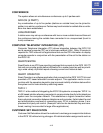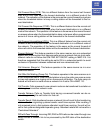
Dialed Number Identification service (DNIS) is a feature of 800 or 900 type num-
bers that allows the number dialed by the caller to be identified in the telephone
system by means of a sequence of DTMF digits (usually four). This service termi-
nates on E&M tie lines. These E&M tie line circuits can terminate on either the iDCS
E&M card or on a channel of a digital T1 circuit on an iDCS TEPRI card.
Direct Dial In (DDI). This is the name given to the above three services when they
are provided over an ISDN PRI circuit.
DIRECT INWARD SYSTEM ACCESS (DISA)
Users can call in on specific DISA lines at any time, input a security code and re-
ceive system dial tone. Users can now place internal calls or if permitted, calls
using C.O. lines. The caller must have a tone dial phone and know his/her DISA
security code. DISA lines can be used as both way lines or incoming only and may
be active in day mode, night mode or both. The C.O. lines used for DISA must have
disconnect supervision. The requirement to put in a DISA security code can be
disabled if desired.
DIRECT TRUNK SELECTION
Each station can be allowed access to or denied access from a trunk or trunk group
by access code when LCR is activated. When restricted, the station user must use
a trunk key or a route key.
DIRECTORY NAMES
Each station, station group and C.O. line may be assigned a directory name (maxi-
mum 11 characters). In addition, each personal speed dial number, system speed
dial number and entry in the DID translation table may be assigned a name (maxi-
mum 11 characters). These names are displayed during calls with these ports and
in the case of station and speed dial names, can be used to originate calls. See the
Dial by Name feature (Station Features).
DISA SECURITY
Telephone fraud and long distance theft are a serious concern. The iDCS 100 pro-
vides a strong DISA security system. If an incorrect DISA passcode is entered re-
peatedly (as is the case with “hackers”), the DISA system can be automatically
disabled temporarily. Both the number of incorrect passcode attempts and the
time that DISA is disabled are programmable. In addition, all failed attempts to
access DISA print on SMDR (if provided) with a “DE” DISA error flag.
DISTINCTIVE RINGING
A user knows the type of call received by the type of ring heard. Outside calls have
a single ring repeated while internal calls have a double ring repeated.
In addition any trunk or station can be programmed to ring a keyset with a pre-
defined ring tone (1–8) or a single line port with a predefined cadence (1–5) selec-
4.14
HOME
PAGE
Table of
Contents


















